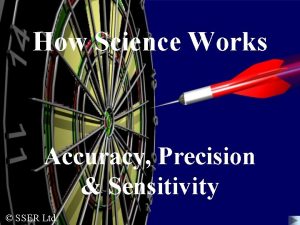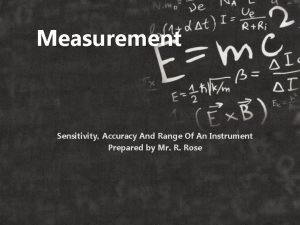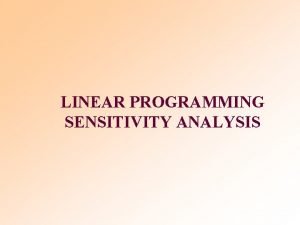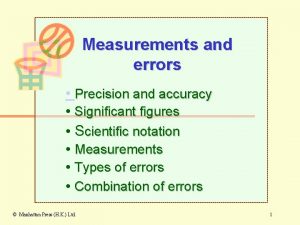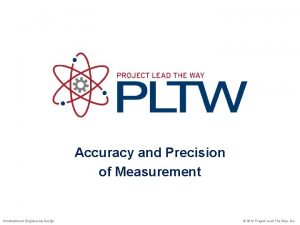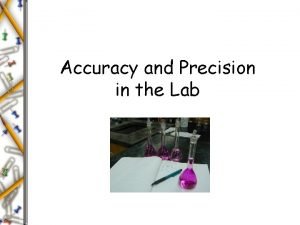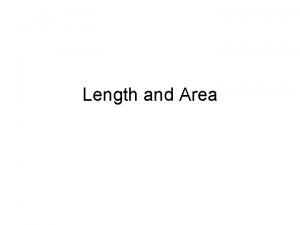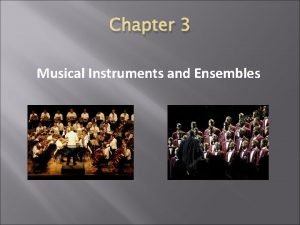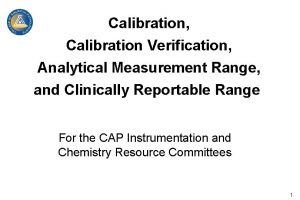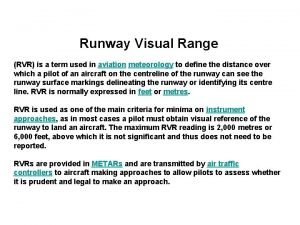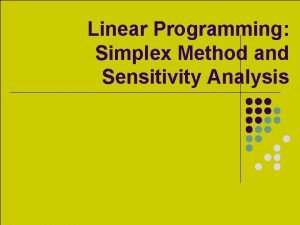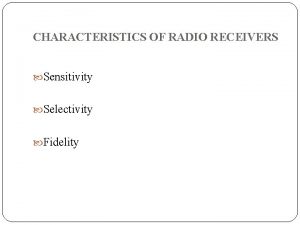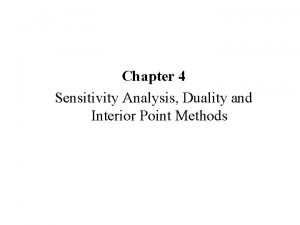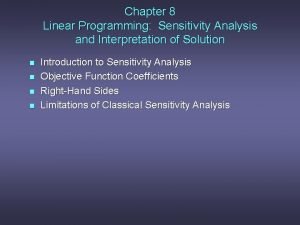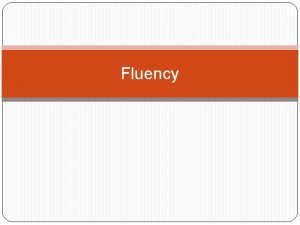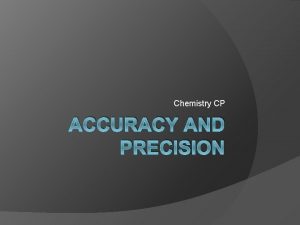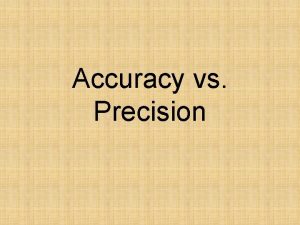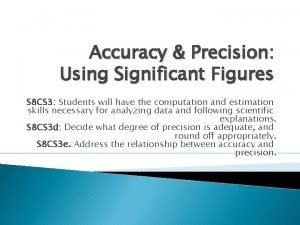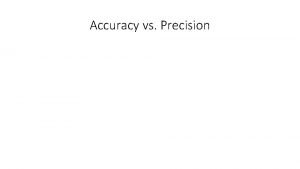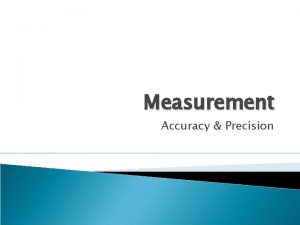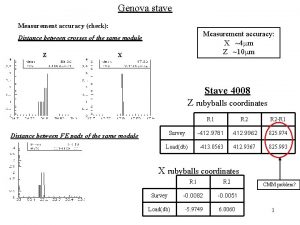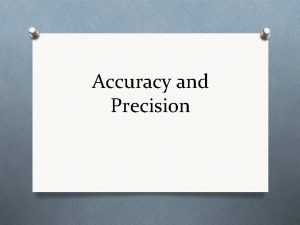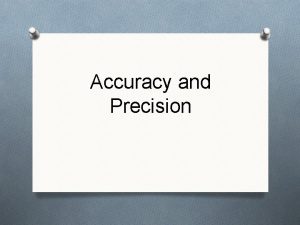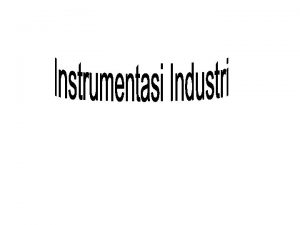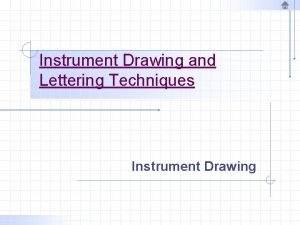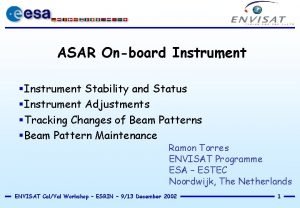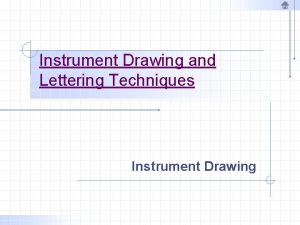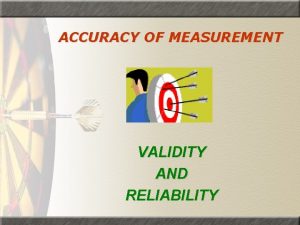Measurement Sensitivity Accuracy And Range Of An Instrument




















- Slides: 20

Measurement Sensitivity, Accuracy And Range Of An Instrument Prepared by Mr. R. Rose

Introduction Instruments which measure the same physical quantity may differ in sensitivity, accuracy and range.

Accuracy and Precision •

Accuracy and Precision continued • If an instrument has a zero error or is incorrectly calibrated then the reading we obtain from the instrument would not be accurate. • On the other hand a reading is precise if it has a small degree of uncertainty with the answer given to several sig. figs. Simply put accuracy is how close you are to the actual value and precision is the consistency that exists amongst a series of values.

The difference between precision and accuracy can be shown by the spread of shooting of a tar -get

Accuracy and Precision continued The accuracy of a measurement can be increased by • taking a number of repeat readings to calculate the mean value of the reading. • avoiding the end errors or zero errors. • taking into account the zero and parallax errors. • using more sensitive equipment such as a vernier caliper to replace a ruler.

Sensitivity • An instrument is sensitive when it can detect or respond to a small change in a particular quantity. Some instruments can detect a change but cannot measure the change e. g. a galvanometer • Measuring instruments that have smaller scale parts are more sensitive. Sensitive instruments need not necessarily be accurate.

The Range • The range of an instrument is the smallest and the greatest value for which the instrument if graduated, stated together • Example: the range of a hand ruler 0 – 15 cm (Don’t forget the units when stating the range)

An instrument’s suitability • An instrument is suitable when it can be used to give a reasonable answer to the quantity we are interested in without undue difficulty. The sensitivity, accuracy and range o an instrument are important in assessing the suitability of the instrument • Example: if we want to measure thickness of a sheet of paper we would not use a ruler because the sensitivity or the smallest division of the ruler is much more than the thickness of a page.

QUESTION TIME

Select the instruments you would use to measure the following. State why you have chosen each instrument and give the range of measurements possible with the instrument and its sensitivity. a) The thickness of a human hair b) The diameter of a table tennis ball c) The area of a window pane d) The inside diameter or bore of a water pipe e) The diameter of a bolt when deciding the size of the hole to drill f) The volume of liquid in a wine bottle

ERRORS

Errors are normally classified in three categories: systematic errors, random errors, and blunders. Blunders • A final source of error, called a blunder, is an outright mistake. A person may record a wrong value, misread a scale, forget a digit when reading a scale or recording a measurement, or make a similar blunder. These blunder should stick out like sore thumbs if we make multiple measurements or if one person checks the work of another. Blunders should not be included in the analysis of data.

Systematic Errors Systematic errors are due to identified causes and can, in principle, be eliminated. Errors of this type result in measured values that are consistently too high or consistently too low. Systematic errors may be of four kinds: 1. Instrumental. For example, a poorly calibrated instrument such as a thermometer that reads 102 o. C when immersed in boiling water and 2 o. C when immersed in ice water at atmospheric pressure. Such a thermometer would result in measured values that are consistently too high. 2. Observational. For example, parallax in reading a meter scale.

Systematic Errors continued 1. Environmental. 2. Theoretical.

Random Errors • Random errors are positive and negative fluctuations that cause about one-half of the measurements to be too high and one-half to be too low. Sources of random errors cannot always be identified. Possible sources of random errors are as follows: • 1. Observational. For example, errors in judgment of an observer when reading the scale of a measuring device to the smallest division.

• Environmental. For example, unpredictable fluctuations in line voltage, temperature, or mechanical vibrations of equipment. Random errors, unlike systematic errors, can often be quantified by statistical analysis, therefore, the effects of random errors on the quantity or physical law under investigation can often be determined.

• An example fitting to distinguish between systematic and random errors is suppose that you use a stop watch to measure the time required for ten oscillations of a pendulum. One source of error will be your reaction time in starting and stopping the watch. During one measurement you may start early and stop late; on the next you may reverse these errors. These are random errors if both situations are equally likely. • Repeated measurements produce a series of times that are all slightly different. They vary in random vary about an average value. • If a systematic error is also included for example, your stop watch is not starting from zero, then your measurements will vary, not about the average value, but about a displaced value.

Blunders • A final source of error, called a blunder, is an outright mistake. A person may record a wrong value, misread a scale, forget a digit when reading a scale or recording a measurement, or make a similar blunder. These blunder should stick out like sore thumbs if we make multiple measurements or if one person checks the work of another. Blunders should not be included in the analysis of data.

Using the Instruments • The vernier caliper • The micrometer • The triple beam balance Clic ko n th e wa tch links tut to oria the ls!
 Sensitivity accuracy precision
Sensitivity accuracy precision Define sensitivity in metrology
Define sensitivity in metrology Sensitivity analysis in lpp
Sensitivity analysis in lpp Accuracy in measurement
Accuracy in measurement Accuracy in measurement
Accuracy in measurement Poor accuracy good precision
Poor accuracy good precision What is the limit of accuracy
What is the limit of accuracy Example of active instruments
Example of active instruments The bowed string instrument with the highest range is the
The bowed string instrument with the highest range is the Calibration verification linearity
Calibration verification linearity Runway visual range measurement
Runway visual range measurement As compared to long-range forecasts, short-range forecasts
As compared to long-range forecasts, short-range forecasts Sensitivity analysis lpp
Sensitivity analysis lpp Fidelity in receiver
Fidelity in receiver Sensitivity analysis and duality
Sensitivity analysis and duality Range of optimality examples
Range of optimality examples Fluency def
Fluency def Accuracy chemistry definition
Accuracy chemistry definition Accuracy v precision
Accuracy v precision Accuracy and precision significant figures
Accuracy and precision significant figures Multiplication of uncertainty
Multiplication of uncertainty
